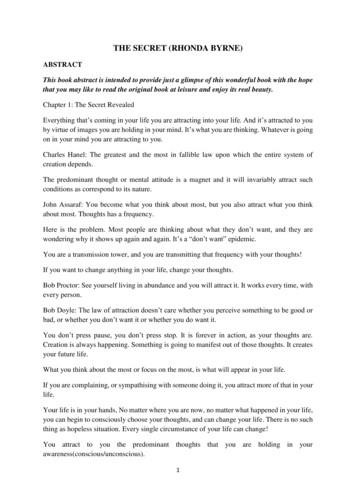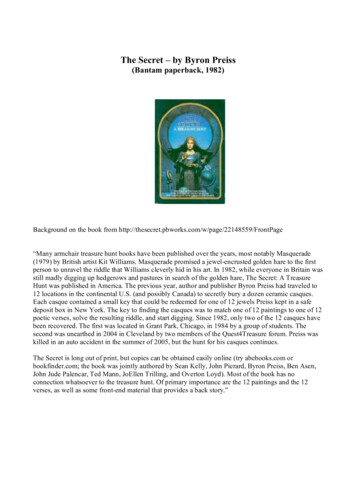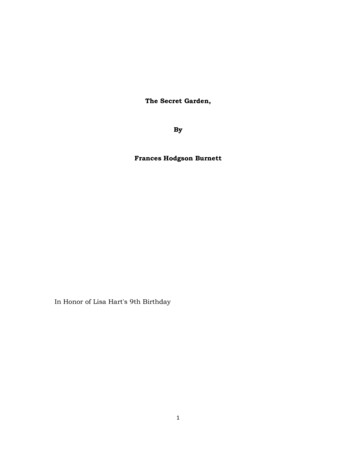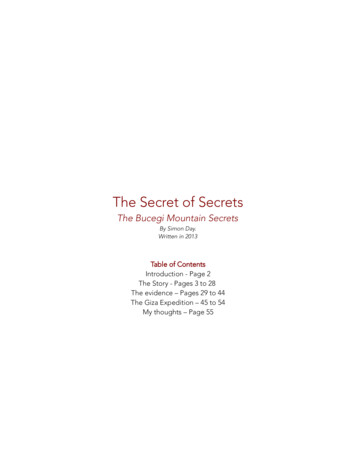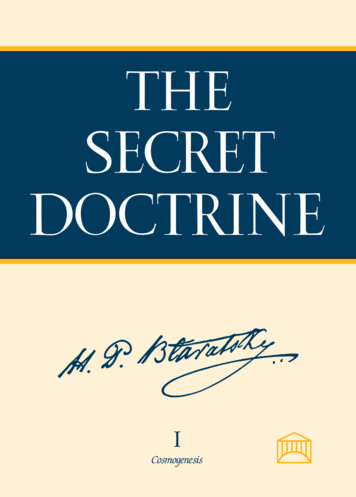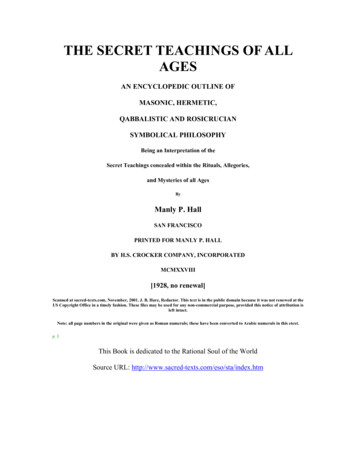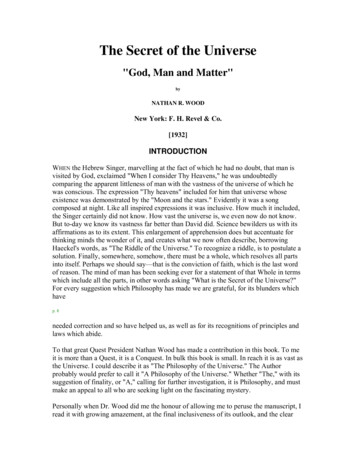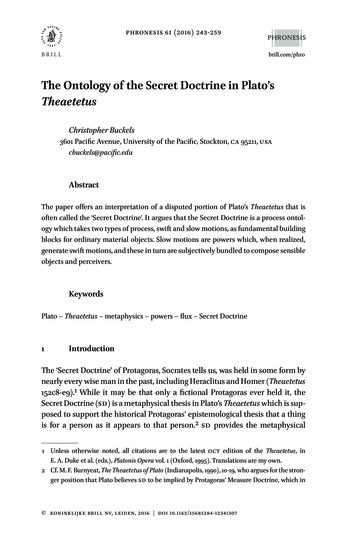
Transcription
Phronesis 61 (2016) 243-259brill.com/phroThe Ontology of the Secret Doctrine in Plato’sTheaetetusChristopher Buckels3601 Pacific Avenue, University of the Pacific, Stockton, CA 95211, USAcbuckels@pacific.eduAbstractThe paper offers an interpretation of a disputed portion of Plato’s Theaetetus that isoften called the ‘Secret Doctrine’. It argues that the Secret Doctrine is a process ontology which takes two types of process, swift and slow motions, as fundamental buildingblocks for ordinary material objects. Slow motions are powers which, when realized,generate swift motions, and these in turn are subjectively bundled to compose sensibleobjects and perceivers.KeywordsPlato – Theaetetus – metaphysics – powers – flux – Secret Doctrine1IntroductionThe ‘Secret Doctrine’ of Protagoras, Socrates tells us, was held in some form bynearly every wise man in the past, including Heraclitus and Homer (Theaetetus152c8-e9).1 While it may be that only a fictional Protagoras ever held it, theSecret Doctrine (SD) is a metaphysical thesis in Plato’s Theaetetus which is supposed to support the historical Protagoras’ epistemological thesis that a thingis for a person as it appears to that person.2 SD provides the metaphysical1 Unless otherwise noted, all citations are to the latest OCT edition of the Theaetetus, inE. A. Duke et al. (eds.), Platonis Opera vol. 1 (Oxford, 1995). Translations are my own.2 Cf. M. F. Burnyeat, The Theaetetus of Plato (Indianapolis, 1990), 10-19, who argues for the stronger position that Plato believes SD to be implied by Protagoras’ Measure Doctrine, which in koninklijke brill nv, leiden, 6 doi 10.1163/15685284-12341307
244Buckelsunderpinning to that thesis by maintaining that everything is continually coming to be; nothing is one stable thing, itself by itself, but all things are constantlychanging from one state to another in relation to one another (152d2-e1); thismetaphysical position is often called a doctrine of radical flux. Such flux supports Protagoras’ epistemological position by ensuring that perception is infallible and that it grasps truth, the two conditions that Theaetetus and Socratesagree knowledge must meet, because each occasion of perception is uniqueand private (cf. 152c5, 186c7-e7).I examine SD and two prominent approaches to it, the Causal TheoryInterpretation (CTI) and the Phenomenalist Interpretation (PI), both ofwhich face grave difficulties. Although I develop an improved version of CTI,it proves to be incompatible with Protagoras’ Measure Doctrine. Plato, however, acknowledges this difficulty; a metaphysics compatible with the MeasureDoctrine would have to be, in the final reckoning, exempt from it. In Section 2,I lay out the basics of SD. In Section 3, I examine CTI and PI and the difficulties that beset these interpretations, and I develop replies to the difficultieson their behalf; each reply requires some significant concession. In Section 4,I develop an improved version of CTI. Finally, Section 5 considers a puzzle thatarises from my version of CTI, but which also shows that Plato acknowledgesCTI’s major concession.2The Secret Doctrine, Radical Flux and PerceptionOur introduction to SD is in the deceptively simple claim that ‘nothing is one,either one thing or one kind of thing, but all things that we say are actuallycome to be in relation to one another from motion and change and blending’(152d6-8). As Socrates spells this out, the implications become clearer: eachthing comes to be in relation to something else; nothing is one thing, itselfby itself, nor is it some determinate thing or kind of thing, but appears differently in relation to different observers, in comparison with different objects, atdifferent times, and in different contexts. His first examples are colors, which(153e6-154a3):3turn is implied by Theaetetus’ definition of knowledge as perception. For arguments againstBurnyeat’s view, see T. Chappell, Reading Plato’s Theaetetus (Indianapolis, 2005), 49-63,and M.-K. Lee, Epistemology After Protagoras: Responses to Relativism in Plato, Aristotle, andDemocritus (Oxford, 2005), 88-92.3 ἐκ τῆς προσβολῆς τῶν ὀμμάτων πρὸς τὴν προσήκουσαν φορὰν φανεῖται γεγενημένον, καὶ ὃ δὴἕκαστον εἶναί φαμεν χρῶμα οὔτε τὸ προσβάλλον οὔτε τὸ προσβαλλόμενον ἔσται, ἀλλὰ μεταξύ τιἑκάστῳ ἴδιον γεγονός.Phronesis 61 (2016) 243-259
The Ontology of the Secret Doctrine in Plato ’ s Theaetetus245. . . appear to have come to be from the approach of the eyes to the appropriate motion, and what we say each color is will be neither that whichapproaches nor that which is approached, but something private to eachthat has come to be between these.Colors are, Socrates claims, private objects that arise from the relation betweenan observer and a visible thing, that is, as a byproduct of two motions (thatof the eyes and that of the visible thing). In fact, Socrates goes on to say, eachobserver and each visible object is always changing (154a6-9). Thus any colorthat arises between me and an object at one time is distinct from the color thatarises between us at another time, since I fail to be the same observer at theone time as I am at the other. We are left with fragmented, momentary entitiesthat exist only in relation to other such entities, all of which are in constantmotion, changing into different momentary entities.Socrates, who reveals SD in several stages, goes on to say that the basicentities of this ontology are not merely in motion but are motions. Thus SDis a process ontology, where motions rather than objects are basic. A doubledichotomy results in four kinds of motion, active and passive on the onehand, and slow and swift on the other. The slow motions move ‘in the sameplace’ and ‘in relation to what comes near’, but when an active slow motion anda passive slow motion interact, they generate swift motions, active and passive,which move about from place to place.4 His main example is seeing a stone;I quote 156d3-e7 in full, since it figures prominently in interpreting SD:5Whenever an eye and something else that has come near it, somethingsymmetric to it, beget whiteness and the sensation appropriate to it,those things that are begotten would never arise if each of the two of4 J. M. Cooper, Plato’s Theaetetus (New York, 1990), 39 suggests that slow motions are changesin quality and swift are changes in location. But this cannot be the whole story, since slowmotions have their motion in relation to things that come close (τὰ πλησιάζοντα, 156c10).If two slow motions must draw near to each other to generate swift motions, at least oneof these interacting slow motions must actually change place. Cf. J. M. Day, ‘The Theory ofPerception in Plato’s Theaetetus 152-183’, Oxford Studies in Ancient Philosophy 15 (1997), 51-80at 64, and Lee, Epistemology, n. 2 above, 106.5 ἐπειδὰν οὖν ὄμμα καὶ ἄλλο τι τῶν τούτῳ συμμέτρων πλησιάσαν γεννήσῃ τὴν λευκότητά τε καὶαἴσθησιν αὐτῇ σύμφυτον, ἃ οὐκ ἄν ποτε ἐγένετο ἑκατέρου ἐκείνων πρὸς ἄλλο ἐλθόντος, τότε δὴμεταξὺ φερομένων τῆς μὲν ὄψεως πρὸς τῶν ὀφθαλμῶν, τῆς δὲ λευκότητος πρὸς τοῦ συναποτίκτοντοςτὸ χρῶμα, ὁ μὲν ὀφθαλμὸς ἄρα ὄψεως ἔμπλεως ἐγένετο καὶ ὁρᾷ δὴ τότε καὶ ἐγένετο οὔ τι ὄψις ἀλλ’ὀφθαλμὸς ὁρῶν, τὸ δὲ συγγεννῆσαν τὸ χρῶμα λευκότητος περιεπλήσθη καὶ ἐγένετο οὐ λευκότης αὖἀλλὰ λευκόν, εἴτε ξύλον εἴτε λίθος εἴτε ὁτῳοῦν συνέβη χρῆμα χρωσθῆναι τῷ τοιούτῳ χρώματι.Phronesis 61 (2016) 243-259
246Buckelsthem had gone to another thing, and at that time, while sight from theeyes and whiteness from that from which color was generated are movingabout between them, the eye becomes filled with sight and sees, and atthat time becomes not at all sight, but a seeing eye, and that which begotthe color is filled with whiteness and becomes, in turn, not whiteness, butwhite, either wood or stone or whatever happens to have such a color.The eye and stone, which play the roles of slow motions, generate twinswhen they are close enough: sensible whiteness and the sensation of seeingwhite. These twins—swift motions—move about between the parents; whilethey move, the eye becomes a seeing eye and the stone becomes a white stone.Proximity causes those slow motions to generate those swift motions, and theseeing eye and a white stone exist only in relation to each other. If the interaction were instead between a stone and hand, the stone would generate roughness, or heaviness, etc. But even in the case of a different eye—two peoplelooking at one rock—the stone generates distinct swift motions for each eye.This whiteness and this act of seeing whiteness have never existed before, norwill they ever exist again; they are private to the stone and the eye. In fact, anobserver cannot see that same whiteness on two separate occasions, for therecan be no same observer at different times. Each observer that seems to be aunified object across times is really an infinite succession of observers, eachdistinct from the last (166b7-c2). The eye that sees whiteness at one time differsfrom the eye that sees whiteness at another. Thus SD denies these apparentcases of identity over time. It is also clear that we are left with a world that isradically dependent on perceivers, where it seems that to be is to be perceived,since nothing is absolutely, but only in relation to some perceiver.When Socrates returns to refute SD, he reveals alteration and locomotion askinds of motion and that all things move in both ways (181c1-e8). This information is not completely surprising; when slow motions were introduced, theycould not be stationary, despite being described as moving in the same place,since they must approach each other to interact. They must also, it seems, bechanging qualitatively; perhaps they are continually altering into powers of different sorts. Likewise, swift motions continually change place, but they mustalso continually change quality. A swift motion of whiteness must change almostimmediately into a different color.6 This consequence is revealed at 182d1-e6:the sensation and sensible are already changing at the very moment they aregenerated. While someone calls the stone ‘white’, its color is already changing; indeed, the very whiteness of the white is changing into something else.6 Cf. Lee, Epistemology, n. 2 above, 105.Phronesis 61 (2016) 243-259
The Ontology of the Secret Doctrine in Plato ’ s Theaetetus247Socrates then contends that Theaetetus’ thesis, that knowledge is perception,is no more true than false, since knowledge changes into non-perception at thevery moment Theaetetus utters his thesis. Although Socrates, Theaetetus andTheodorus abandon the theory, we may still ask if the theory is consistentand whether Plato endorses any part of it. In the next section, we examine twointerpretations that try to make sense of SD, as well as the problems they face.3Interpretations of the Secret DoctrineThere are two prominent approaches to resolving SD’s difficulties, which JaneDay, following Crombie, labels the ‘Causal Theory’ interpretation (CTI) andthe ‘Phenomenalist’ interpretation (PI).7 According to CTI, SD gives a physicalexplanation of how perceivers and objects, which are slow motions, generatesensations and sensible properties, which are, in turn, swift motions. In Day’swords (with her emphasis): ‘Physical objects in interacting cause perceivedqualities to arise, which in turn constitute perceptual objects.’ This interpretation assumes the existence of physical objects, which is why proponents ofPI reject it; they take sensations and sensibles—swift motions—as the basicentities of this flux ontology. According to PI, swift motions explain and evencompose perceivers and ordinary objects. Day explains: ‘The “slow” fluxes areidentified with the “aggregates”, and thus are taken as being logically dependent on the “quicker” fluxes, as opposed to causing them.’ In other words, slowmotions are constituted by swift motions. Although PI seems to give a better theory of perception, since it uses only phenomenally-accessible entities,namely swift motions, it is problematic because it reverses the causal dependency indicated in the text, making slow motions dependent on swift motionsrather than vice versa.Day admits that both interpretations are problematic but argues that CTI ismore so. As she explains CTI, slow motions are physical objects which begetswift motions, and these swift motions produce sensible objects.8 Thus thereare two types of entity, physical and sensible. Physical objects, it seems, are notsensible, nor are sensible objects physical; the problem is that the text does7 Day, ‘Perception’, n. 4 above, 65; cf. Burnyeat, Theaetetus, n. 2 above, 16 (calling the two interpretations the ‘physical’ and ‘metaphysical’ theories, respectively); Lee, Epistemology, n. 2above, 96 n. 38.8 Day appears to be following J. W. Yolton, ‘The Ontological Status of Sense-Data in Plato’sTheory of Perception’, Review of Metaphysics 3 (1949), 21-58, in describing the Causal Theoryinterpretation.Phronesis 61 (2016) 243-259
248Buckelsnot make this distinction. One may also press CTI about these entities: howcan an object be physical but non-sensible? Day attacks details of CTI’s proposed causal story: ‘How can it be said that when sight travels from the eyethe eye comes to be “full of sight”, or that when the whiteness travels from theobject the object is “filled up with whiteness”? (156d6-e5).’9 To explain thiscausally seems hopeless, as the eye should be empty of sight if sight travelsfrom it, not full of sight. Finally, Day compares perception in the Theaetetuswith the Timaeus, which makes clear, she argues, that ‘Plato makes no move toexplain perception causally’ in the Theaetetus, since he does try to do this inthe markedly different Timaeus. Thus the causal story portrayed in the text is,according to Day, mostly figurative: Plato is not trying to give us a causal theoryof perception.Although PI looks fairly attractive according to this reasoning, it takes thetext to be so figurative as to be unreliable as the basis of a theory.10 The textexplicitly states that swift motions are generated from slow motions, so aninterpretation should be able to explain this rather than explaining it away.The theory might be in tension with itself, as Day ultimately claims, but itshould not obviously be so, as it would be if swift motions are generated byslow motions and also compose them.11 On the one hand, it is implausible thatPlato intends slow motions to be dependent upon swift motions and yet, onthe other, it is also implausible to distinguish physical and sensible objects.It would be helpful to clarify what is at stake between the two interpretations.Prima facie, very little: Socrates ultimately refutes SD, and either interpretationcan be used to show that a metaphysics that can support Protagoras’ MeasureDoctrine—that man is the measure of what is—must ultimately fail in someway. But the interesting question is precisely how the theory fails. According toPI, sensations and sensible properties come from nowhere, which gives us adubitable metaphysics from the start. A reader should question whether Platohas given us any support for the Measure Doctrine: surely he could do better!But, according to CTI, support comes via physical objects that are exceptionsto the Measure Doctrine, which hardly seems better. In the next section, I hopeto give a more satisfying alternative to these.9 Day, ‘Perception’, n. 4 above, 66. Day indicates that she is taking this question fromCrombie.10 Day (‘Perception’, n. 4 above, 68) shares this worry, but she writes that we can ‘nevertheless describe the theory as predominantly, even if not consistently’ phenomenalist.11 Day, ‘Perception’, n. 4 above, 70: ‘Such a theory [as we get on her interpretation] is ofcourse logically incoherent, as there is no fixed term by reference to which the others canbe explained or defined.’Phronesis 61 (2016) 243-259
The Ontology of the Secret Doctrine in Plato ’ s Theaetetus249First, though, let us investigate the two interpretations in more detail,beginning with Day’s arguments against CTI. One is directed against thecausal credentials of the theory: how can an eye be full of sight when sightmoves from the eye? In the relevant passage, 156d3-e7, Socrates says: ‘whilesight from the eyes and whiteness from that which generated the color aremoving about between them, at that time the eye becomes filled with sightand sees, and then it becomes not at all sight, but a seeing eye.’ The text tellsus that swift motions move between two slow motions that have come closeto each another. But commentators often add an extra detail, borrowed fromthe Timaeus: swift motions, they say, move from one slow motion to another.12Some commentators even write that two swift motions meet and commingle.13This meeting is not, however, in the text. Of course these details seem naturalsupplementations, as one might imagine one swift motion as a ray of light thatleaps from eye to stone and the other as a ray of light that emanates or bouncesfrom stone to eye. Perhaps these rays meet in the middle and rebound to theirparents, or perhaps they continue on their way to stone and eye, respectively.The rays might even fuse into a ‘pencil of energy’ or ‘pencil of light’.14But the Theaetetus does not supply such details.15 Instead, swift motionsare said to move from slow motions and to move about between them. If proximity suffices to cause slow motions to beget swift, why must swift motionsmake contact with each other or either slow motion? We should leave it as thetext does: swift motions move between slow motions, and the eye is filled withsight and the stone with whiteness at the same time as the swift motions are12 E.g. J. McDowell, Plato: Theaetetus (Oxford, 1973), 139-40. Cf. Day, ‘Perception’, n. 4above, 66.13 E.g. Yolton, ‘The Ontological Status’, n. 8 above; George Nakhnikian, ‘Plato’s Theory ofSensation’, Review of Metaphysics 9 (1955), 129-48 and 306-27 at 139.14 Nakhnikian, ‘Plato’s Theory’, n. 13 above, 142-3, 149-50: ‘According to Theaetetus 156E,προσβάλλον and προσβαλλόμενον meet and form a continuous “pencil” of light.’ The onlyclaim in 156e that appears to give any support to this statement is the claim that sightand whiteness are ‘moving between’ the eye and stone (μεταξὺ φερομένων, 156d6-e1).Nakhnikian appears to be incorporating the Timaeus’ account of vision and relying, inpart, on Taylor’s interpretation thereof. Cf. F. M. Cornford, Plato’s Theory of Knowledge:The Theaetetus and the Sophist of Plato (New York, 1957), 50.15 One could, of course, show how the Timaeus and Theaetetus do not contradict, and onecould even try to show how the Timaeus develops the Theaetetus’ account of perception,but this is not necessary for understanding the Theaetetus itself, and it might actuallyhinder understanding.Phronesis 61 (2016) 243-259
250Buckelsmoving about in the middle.16 It is not said that swift motions need completeany particular course of movement at all: they simply move in the ‘in-between’.The text is fully compatible with sight returning to the eye (to fill it with sight)or with the eye being filled with sight merely by proximity to sight movingabout nearby. Since proximity suffices for generating swift motions, it shouldalso suffice for producing a seeing eye. There is, then, no problem with a causalexplanation of the eye becoming filled with sight.Day could grant this claim but press another criticism: if Plato merely leavesopen ways to build a causal account of perception from the text, then he is notdetailing such an account. If he were, he would certainly include such relevantcausal details as how the eye becomes filled with sight. He does include suchdetail, after all, in the Timaeus. But this hardly seems an objection: the Timaeusis the right place for Plato to give all the physical details relevant to an accountof perception. The Theaetetus, by contrast, is not, just as it is not the right placeto solve, for example, the problem of not being. One must go to the Sophist tofind this task taken up, just as one must go to the Timaeus to find a completephysical account of perception. In the Theaetetus Plato simply lays the foundations of a plausible theory of perception—whether he endorses it or not—inorder to examine the contention that knowledge is perception, along with theaccompanying and supporting contention that nothing is one thing, itself byitself, but everything becomes what it becomes in relation to something else.1716 The claim that swift motions make contact with the sense organ and object of sensationmay be due, in part, to how related passages are translated. At 153e6-154a3 (quoted abovein the main text), colors are said to come to be from the approach (προσβολή) of the eyes tothe appropriate (προσήκουσαν) motion. Many translators render προσβολή as ‘impact’: e.g.Burnyeat, Theaetetus, n. 2 above, ad loc., and H. N. Fowler, Plato: Theaetetus (Cambridge,Mass., 1921), ad loc. Cf. Day, ‘Perception’, n. 4 above, who uses ‘encounter’ (53), andCornford, Plato’s Theory of Knowledge, n. 14 above, 40, who uses ‘meeting’. While ‘impact’is a common meaning of προσβολή, it is an over-translation here, since an impact requirescontact and προσβολή does not. If there were contact, it is difficult to see how color couldarise ‘between’ the two motions. Instead, the notion προσβολή conveys is that of something ‘thrown toward’ another thing, often in an attack. Accordingly, we should not translate τὸ προσβάλλον and τὸ προσβαλλόμενον as requiring contact, e.g. that which collides andthat with which it collides, but as that which approaches and that which is approached;Cf. McDowell, Theaetetus, n. 12 above, followed by Lee, Epistemology, n. 2 above, 95.17 Plato need not endorse the theory himself, even if Theaetetus agrees with Socrates that itis a plausible theory. It need only be plausible to the characters and, perhaps, the intendedaudience.Phronesis 61 (2016) 243-259
The Ontology of the Secret Doctrine in Plato ’ s Theaetetus251The foundations of a causal theory are sufficient for that purpose—it matters not how the eye is filled with whiteness, just that this happens while andbecause sight is moving about between the eye and object. Thus we can layaside these two criticisms of CTI.Let us take a closer look at PI. David Sedley, a representative thereof, writesthat slow motions, or ‘parents’, are ‘simply bundles of perceptual twins’.18This thesis streamlines SD; parents are bundles of offspring, which generatenew offspring (and new parents). SD thus eliminates all entities except sensible properties and sensations, since the former completely constitutesensible objects and the latter completely constitute perceivers. Even spacemay be relativized, as Sedley points out, because sensibles and perceivers maybe located relative to one another rather than absolutely.Let us look more closely at swift motions. We are given such examples as hotand hard and white (156e6-8). These are sensible properties. In fact, they areinstances of such properties, since each sensation is private and distinct fromevery other: this whiteness is distinct from that whiteness. Nonetheless thesetwo can be qualitatively indistinguishable, i.e. resemble each other exactly,and so are both instances of whiteness, although SD would deny that there isa Whiteness over and above the instances. In other words, SD is a sort of tropenominalism. Tropes, or property-instances, are such things as this heat andthis whiteness, and Heat, the universal, is simply the group of all heat tropes.The range of tropes in the Theaetetus extends beyond sensible properties. Inaddition to this whiteness, we have this act of seeing whiteness; in addition tothis heat, we have this act of feeling heat. Both members of each pair must beof the same ontological kind, since the sensible property and the sensation areboth swift motions. They are also both particular, since a different observerwould see a different white from what I see, even if we both observe the sameshade of white. If swift motions are tropes, then PI can identify all objects,perceivers and perceived alike, as bundles of tropes. This makes SD a singlecategory ontology.So far, however, PI has not given us a response to one major objection: thetext explicitly states that slow motions generate swift motions. How can thishappen, if slow motions are bundles of swift motions? A regress threatens: eachslow motion is constituted by previously existing swift motions, which werethemselves produced by slow motions. There must be some slow motions thatfirst began producing swift motions without themselves being constituted of18 D. N. Sedley, The Midwife of Platonism (Oxford, 2005), 46.Phronesis 61 (2016) 243-259
252Buckelsswift motions.19 Although this argument renders PI problematic, it may pushthe text too hard: it seems that Plato is not laying out every detail of a theoryof perception but is merely giving readers enough information to understand(and refute) SD and Protagoras’ Measure Doctrine.PI does, however, run into a more serious difficulty. Consider the case of thestone and eye: each must be, according to PI, a bundle of swift motions whichin turn generates swift motions. Swift motions are sensibles and sensations:in this case, they are whiteness and sight. But Socrates clearly reveals thatthe stone and eye are not sensed or sensing until swift motions pass betweenthem. The eye is not a seeing eye, nor is the stone a white stone, until two slowmotions draw close enough to generate swift motions. If the stone is not whiteuntil the eye approaches, it cannot be an aggregate of sensible properties suchas whiteness; an imperceptible stone cannot be a bundle of sensible properties! Likewise, the eye cannot be a bundle of sensations before it producessight. We need pre-existing slow motions to generate sensation and sensibles,which PI firmly denies. So let us return to CTI, which gives us such entities, tosee if it can be salvaged.4A Second Look at CTISensibles, such as whiteness and hardness, and sensations, such as seeing andfeeling, are swift motions, which are generated from slow motions comingclose to one another. But, setting aside slow motions for the moment, whatare people and stones? Socrates suggests an answer: human beings and stonesare aggregates (ἁθροίσματα, 157b8-c1). He does not say of what they are aggregates, but, since a stone becomes a white stone by being filled with whiteness(156e4-7), and the same with hardness and heat and all the rest of such qualities (156e7-9), it seems that stones and the like are aggregates of sensibles.A stone is an aggregate of whiteness, hardness and other sensible properties.In addition, since nothing is one thing itself by itself, but all things come aboutfrom motion through their mutual interaction (156e9-157a2), the stone onlyexists in relation to an observer, who, in turn, exists only in relation to the stoneand whatever else is observed at that moment. Thus, the observer is also anaggregate, namely an aggregate of sensations, such as a seeing eye, hearingear etc., and in addition of sensibles, since perceivers are perceived by other19 M. Matthen, ‘Perception, Relativism, Truth: Reflections on Plato’s Theaetetus 152-160’,Dialogue 24 (1985), 33-58, points out that a regress develops: there must be a first parent(a first generator) somewhere along the line.Phronesis 61 (2016) 243-259
The Ontology of the Secret Doctrine in Plato ’ s Theaetetus253perceivers. These two aggregates (sensing and sensible) are even separable,so that Socrates qua perceiver is not the same as Socrates qua perceived byTheaetetus.20 In fact, this latter Socrates would differ, in turn, from Socratesqua perceived by Theodorus. Where there seems to be one person, there arein fact three. As perceivers increase, so do Socrateses, until there are countlessmen where there seemed to be but one (cf. 166b7-c2).It is, however, difficult to reconcile this picture with CTI’s slow and swiftmotions. If the stone is a mere aggregate of sensible properties, which areswift motions, then what are slow motions? As Day explains CTI, slow motionsare physical objects which beget swift motions, and these swift motions produce sensible objects.21 The distinction between physical and sensible objectsis problematic, as Day argues, because it is not in the text. But is CTI committed to it? Since the distinction cannot be found in the text, let us use one20 Yolton, ‘The Ontological Status’, n. 8 above, does not seem to account for this when heinfers that there is a problem applying the theory of perception to other perceptions thansight. Yolton takes touch as a particular problem, since, he says, when one sees colors inan object, one does not become so colored, but when one feels hotness or coldness, onedoes become hot or cold (28-9). There are several things to point out in regard to thisclaim, but the first is that we do not see color in an object. In the process of perception,the eye becomes a seeing eye, and the stone, for example, becomes a white stone; butsight and whiteness move about between the eye and the stone. Applying this to touch, wewould imagine that the skin becomes touching skin, and the stone becomes a hot stone,when touch and hotness move about between the skin and stone. It must be granted, ofcourse, that there is not much room between these two, but this is not a serious obstacleto the theory. In touching a hot stone, the skin may indeed become hot itself, due to whatLocke calls a tertiary quality, but a distinction must be made between skin that is feelinghotness, that is, the sensing skin, and skin that feels hot, that is, skin that is hot to thetouch. According to SD, these skins are different objects, for one is a sense organ that hasa certain unique perception, namely heat, and the other is a perceptual object that is perceived by another sense organ. So if I touch a ston
The Ontology of the Secret Doctrine in Plato’s Theaetetus Christopher Buckels 3601 Pacific Avenue, University of the Pacific, Stockton, CA 95211, USA cbuckels@pacific.edu Abstract The paper offers an interpretation of a disputed portion of Plato’s Theaetetus tha




